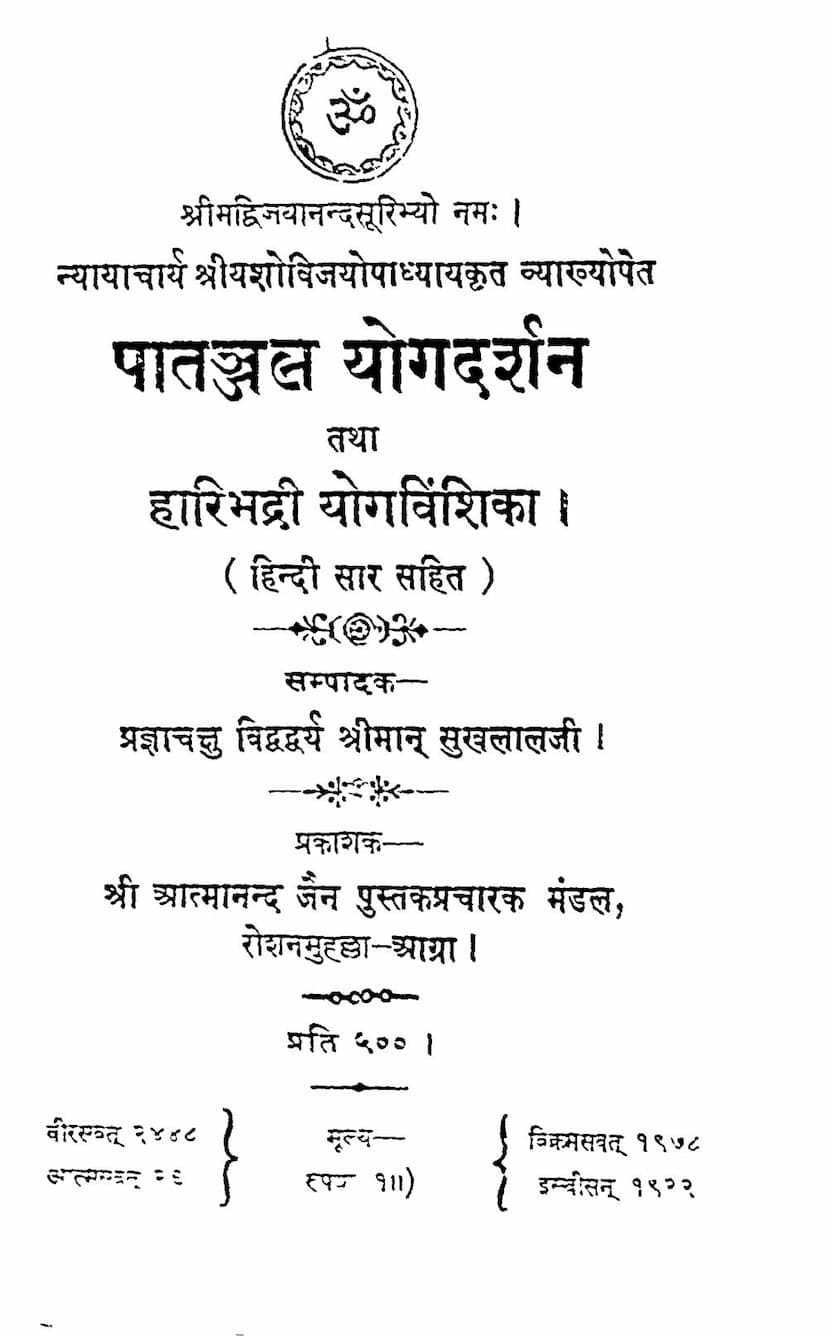Patanjal Yogdarshan Tatha Haribhadri Yogvinshika
Added to library: September 2, 2025

Summary
Here's a comprehensive summary of the Jain text "Patanjal Yogdarshan tatha Haribhadri Yogvinshika" by Sukhlal Sanghavi, based on the provided content:
Overview
This book, "Patanjal Yogdarshan tatha Haribhadri Yogvinshika," edited by Sukhlal Sanghavi and published by Shri Atmanand Jain Pustak Pracharak Mandal, presents a critical analysis and compilation of two significant works related to Yoga: Maharshi Patanjali's Yoga Sutras with a Jain commentary (Vṛtti) by Yashovijaya, and Acharya Haribhadra Suri's Yogavimśatikā with a commentary. The book aims to bridge the gap in understanding between Vedic and Jain philosophical traditions concerning Yoga, highlighting their similarities and differences from a Jain perspective.
Key Sections and Content
-
Introduction (Parichay) and Preface (Prastavana):
- The book begins with an essay on Yoga and its related literature, establishing the importance and context of Yoga.
- It emphasizes that Yoga is not a proprietary possession of any single culture or nation, but a universal pursuit of spiritual development.
- The preface explains the book's objective: to provide a deeper understanding of Yoga, its history, and its integration within Jain philosophy.
-
Patanjali's Yoga Darshan (with Jain Vṛtti by Yashovijaya):
- Patanjali: The work acknowledges Maharshi Patanjali as the author of the Yoga Sutras, noting the scholarly debate regarding his identity and time period. Regardless of his historical details, his philosophical contributions through the Yoga Sutras are highly regarded.
- Yoga Sutras: The book presents Patanjali's Yoga Sutras, which are based on Sankhya philosophy. The sutras outline the theory and practice of Yoga.
- Jain Vṛtti (Commentary) by Yashovijaya: This is a unique aspect of the book. Yashovijaya, a prominent Jain scholar, has provided a commentary on selected Yoga Sutras (27 out of 195). His commentary is significant because it:
- Explains the Yoga Sutras from a Jain philosophical standpoint.
- Highlights areas where Jainism agrees with or differs from the Sankhya-based Yoga philosophy.
- Aims to foster mutual respect and understanding between Vedic and Jain traditions by showing their points of convergence and divergence.
- The commentary is concise but insightful, demonstrating the author's broad scholarship and ability to synthesize different philosophical viewpoints.
- Sankhya vs. Jain Perspective: The Vṛtti specifically addresses the differences and similarities between Sankhya's approach to concepts like Purusha (consciousness) and Prakriti (matter) and the Jain understanding of soul (Jiva) and matter (Ajiva).
- Syādvāda and Liberalism: Yashovijaya's Vṛtti is presented as an embodiment of Syādvāda, the Jain principle of manifold perspectives. It encourages respect for differing viewpoints and highlights the expansive and tolerant nature of Jain philosophy.
-
Haribhadra Suri's Yogavimśatikā:
- Haribhadra Suri: Acharya Haribhadra Suri (circa 8th-9th century CE) is recognized as a seminal figure in Jain intellectual history. He is known for his prolific writings, his ability to synthesize different philosophies, and his pioneering work in writing Sanskrit commentaries on Jain Agamas. He is also noted for his contributions to various fields, including logic, grammar, and philosophy.
- Yogavimśatikā: This is a short work in Prakrit, consisting of twenty verses (gāthās) on Yoga. It is part of a larger series of "vimśatikās" (works of twenty verses) by Haribhadra Suri. The Yogavimśatikā specifically deals with the practice and principles of Yoga.
- Jain Perspective on Yoga: Haribhadra Suri's works, including this one, present Yoga from a distinctly Jain perspective, focusing on the path to liberation through spiritual practices.
- Social Commentary: The Yogavimśatikā also contains a subtle critique of corrupt spiritual leaders who exploit devotees. It asserts that true spiritual communities are defined by adherence to scriptures, not mere numbers.
- Higher Yoga Practices: The text also discusses meditation on forms and formless states.
- Commentary on Yogavimśatikā: The book includes a Sanskrit commentary on the Yogavimśatikā, which is praised for its clarity and comprehensiveness, showcasing the commentator's deep knowledge.
-
Yashovijaya's Contributions:
- Yashovijaya is highlighted as the author of the commentaries on both Patanjali's Yoga Sutras and Haribhadra's Yogavimśatikā included in this book.
- His scholarship is lauded for its synthesizing ability, its deep engagement with both Jain and non-Jain texts, and its balanced presentation of complex ideas. He is described as a scholar who fearlessly presented truth, transcending sectarian boundaries.
-
The Role of Hindi Summaries:
- The book includes Hindi summaries of both the Yoga Sutra Vṛtti and the Yogavimśatikā.
- The purpose of these summaries is to make the profound philosophical content accessible to a wider audience, particularly those who may not be fluent in Sanskrit or Prakrit.
- The summaries are not mere translations but insightful distillations of the original text's essence, carefully crafted to convey the core ideas and nuances.
-
Historical and Philosophical Significance:
- The book emphasizes the continuity of Yoga practices and thought across different Indian philosophical traditions, particularly highlighting the Jain contribution.
- It underscores the Jain tradition's rich engagement with Yoga, dating back to its early scriptures and continuing through scholars like Haribhadra Suri and Yashovijaya.
- The book serves as a valuable resource for understanding the philosophical dialogue between Jainism and other Indian schools of thought, particularly on the subject of Yoga.
Overall Theme and Purpose
The primary aim of "Patanjal Yogdarshan tatha Haribhadri Yogvinshika" is to present a comprehensive and accessible exploration of Yoga from a Jain perspective. It seeks to:
- Educate: Introduce readers to the foundational texts of Yoga (Patanjali) and their important Jain interpretations (Haribhadra, Yashovijaya).
- Integrate: Demonstrate the deep philosophical engagement of Jainism with Yoga, showing how Jain principles inform and enrich the understanding of Yogic practices.
- Promote Understanding: Bridge the gap between different philosophical schools by highlighting areas of agreement and disagreement, fostering tolerance and intellectual dialogue.
- Accessibility: Make complex philosophical concepts accessible through Hindi summaries and clear explanations.
- Scholarship: Showcase the profound scholarship of Sukhlal Sanghavi and the featured authors.
The book is a testament to the Jain tradition's intellectual rigor and its commitment to synthesizing and understanding diverse philosophical streams for the ultimate goal of spiritual liberation.